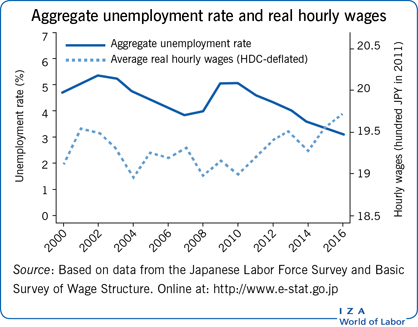Elevator pitch
As the third-largest economy in the world and a precursor of global trends in population aging, Japan's recent experiences provide important lessons regarding how demographic shifts affect the labor market and individuals’ economic well-being. On the whole, the labor market showed a remarkable stability during the financial crisis, despite decades of economic stagnation and sluggish real wage growth. Rapid population aging, however, has brought substantial changes to individuals in the labor market, most notably women, by augmenting labor demand in the healthcare services industry.

Key findings
Pros
Japan's aggregate unemployment rate has been relatively stable and low.
Women's employment is increasing quickly, while the employment rate among men remains high.
Japan's gender wage gap is shrinking.
Average real wages have been growing recently, most notably among women.
The magnitude of wage inequality in Japan remains relatively small.
Cons
Japan's working-age population has been declining rapidly.
Rising employment among women in Japan coincides with a decline in the marriage rate, which may further accelerate population decline.
Japan's gender wage gap remains substantial.
Wage inequality among men in Japan has increased at the upper end of the wage distribution.
Job stability in Japan has declined as jobs with fixed-term contracts have become more prevalent.